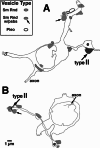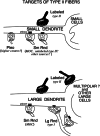Postsynaptic targets of type II auditory nerve fibers in the cochlear nucleus
- PMID: 15357415
- PMCID: PMC2538406
- DOI: 10.1007/s10162-003-4012-3
Postsynaptic targets of type II auditory nerve fibers in the cochlear nucleus
Abstract
Type II auditory nerve fibers, which provide the primary afferent innervation of outer hair cells of the cochlea, project thin fibers centrally and form synapses in the cochlear nucleus. We investigated the postsynaptic targets of these synapses, which are unknown. Using serial-section electron microscopy of fibers labeled with horseradish peroxidase, we examined the border of the granule-cell lamina in mice, an area of type II termination that receives branches having swellings with complex shapes. About 70% of the swellings examined with the electron microscope formed morphological synapses, which is a much higher value than found in previous studies of type II swellings in other parts of the cochlear nucleus. The high percentage of synapses enabled a number of postsynaptic targets to be identified. Most of the targets were small dendrites. Two of these dendrites were traced to their somata of origin, which were cochlear-nucleus "small cells" situated at the border of the granule-cell lamina. These cells did not appear to receive any terminals containing synaptic vesicles that were large and round, indicating a lack of input from type I auditory nerve fibers. Nor did type II swellings or targets participate in the synaptic glomeruli formed by mossy terminals and the dendrites of granule cells. Other type II synapses were axosomatic and their targets were large cells, which were presumed multipolar cells and one cell with characteristics of a globular bushy cell. These large cells almost certainly receive additional input from type I auditory nerve fibers, which provide the afferent innervation of the cochlear inner hair cells. A few type II postsynaptic targets-the two small cells as well as a large dendrite-received synapses that had accompanying postsynaptic bodies, a likely marker for synapses of medial olivocochlear branches. These targets thus probably receive convergent input from type II fibers and medial olivocochlear branches. The diverse nature of the type II targets and the examples of segregated convergence of other inputs illustrates the synaptic complexity of type II input to the cochlear nucleus.
Figures









References
-
- Benson TE, Brown MC. Synapses formed by olivocochlear axon branches in the mouse cochlear nucleus. J. Comp. Neurol. 1990;295:52–70. - PubMed
-
- Benson TE, Berglund AM, Brown MC. Synaptic input to cochlear-nucleus dendrites that receive medial olivocochlear synapses. J. Comp. Neurol. 1996;365:27–41. - PubMed
-
- Berglund AM, Brown MC. Central trajectories of type-II spiral ganglion cells from various cochlear regions in mice. Hear. Res. 1994;75:121–130. - PubMed
-
- Berglund AM, Benson TE, Brown MC. Synapses from labeled type II axons in the mouse cochlear nucleus. Hear. Res. 1996;94:31–46. - PubMed
-
- Brawer JR, Morest DK. Relations between auditory nerve endings and cell types in the cat’s anteroventral cochlear nucleus seen with the Golgi method and Nomarski optics. J. Comp. Neurol. 1975;160:491–506. - PubMed
Publication types
MeSH terms
Grants and funding
LinkOut - more resources
Full Text Sources

